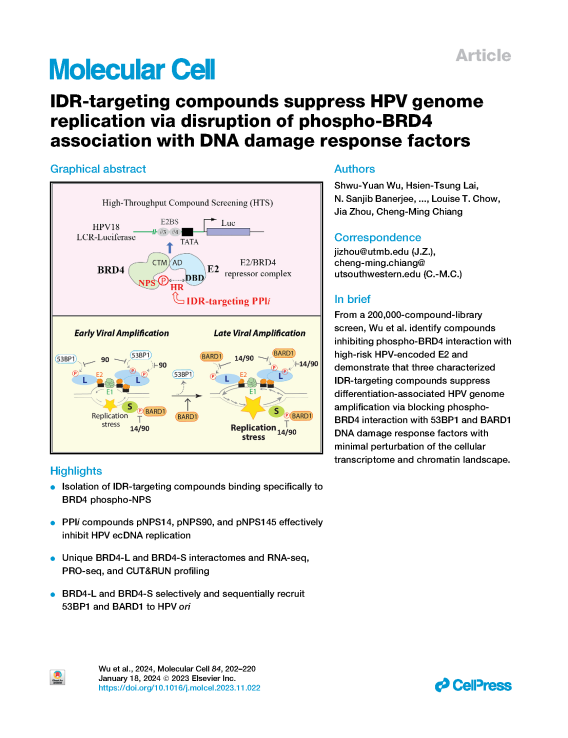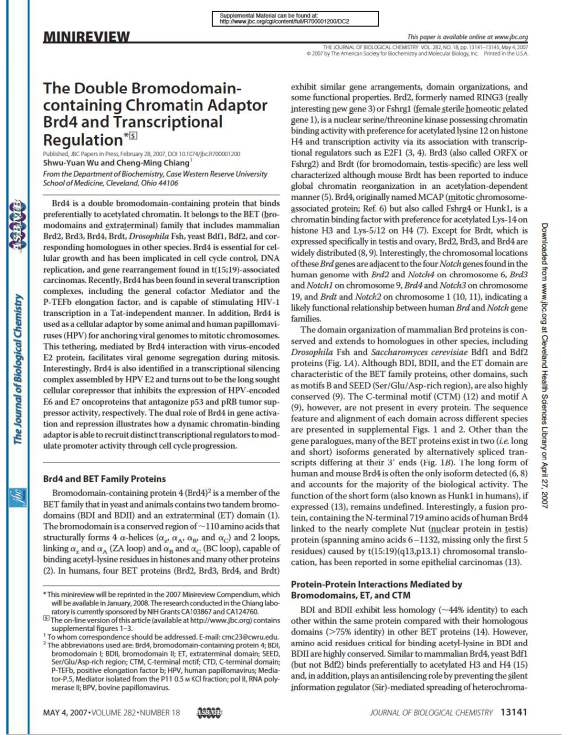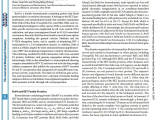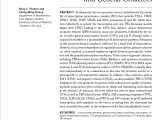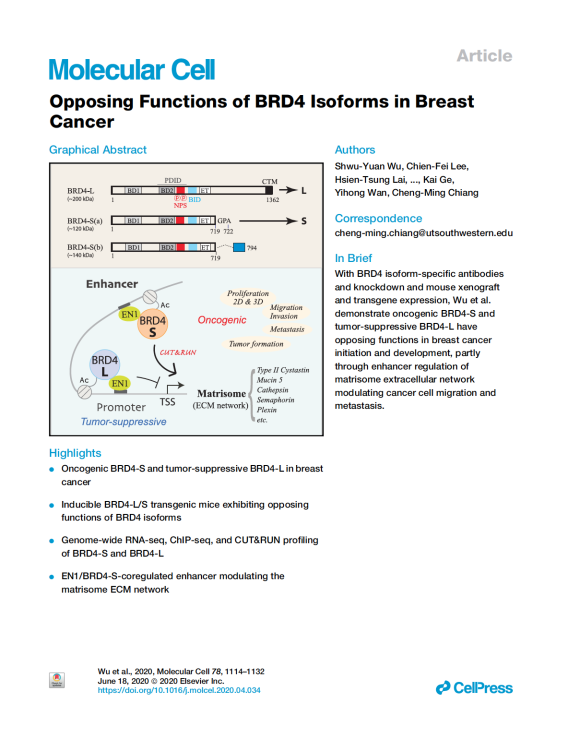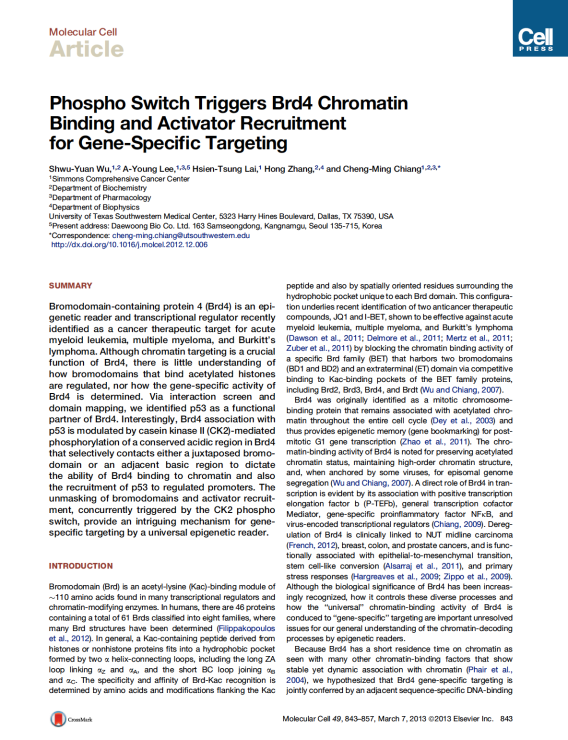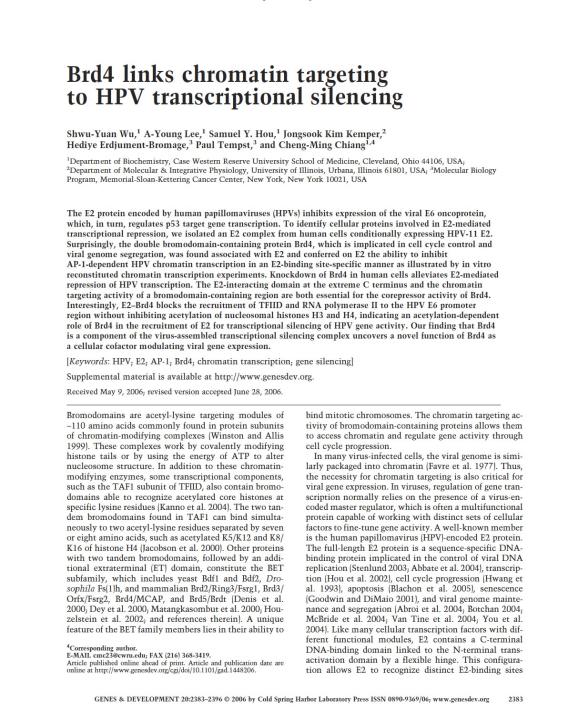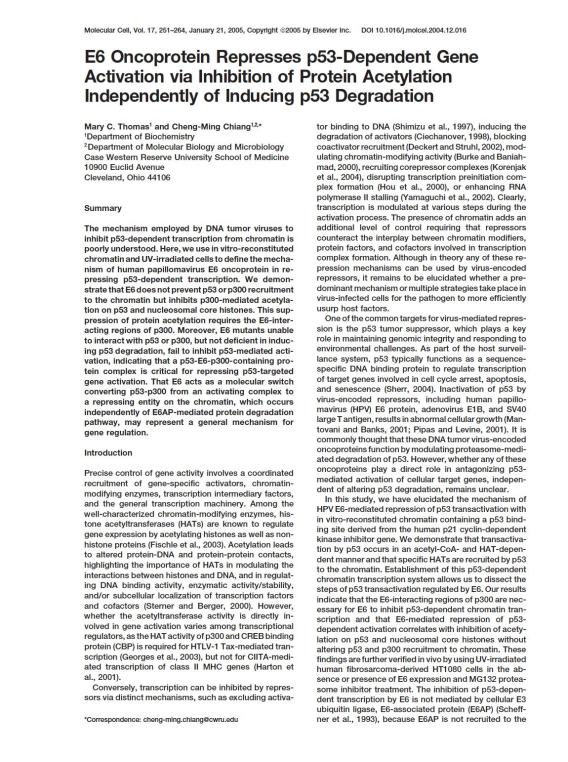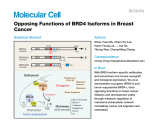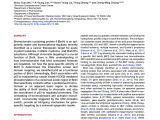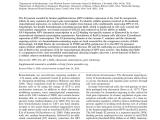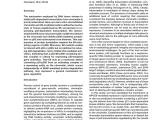Wu, S.-Y., H.T. Lai, N.S. Banerjee, Z. Ma, J.F. Santana, S. Wei, X. Liu, M. Zhang, J. Zhan, H. Chen, B. Posner, Y. Chen, D.H. Price, L.T. Chow, J. Zhou, and C.-M. Chiang. 2024. IDR-targeting compounds suppress HPV genome replication via disruption of phospho-BRD4 association with DNA damage response factors. Molecular Cell 84: 202-220.
Das, D., J.Y. Leung, S. Balamurugan, V. Tergaonkar, A.H.P. Loh, C.-M. Chiang, and R. Taneja. 2024. BRD4 isoforms have distinct roles in tumor progression and metastasis in rhabdomyosarcoma. EMBO Reports, 2024 Jan 8. doi: 10.1038/s44319-023-00033-1. Online ahead of print.
Prabhakar, A.T., C.D. James, C.T. Fontan, R. Otoa, X. Wang, M.L. Bristol, C. Yeager, R.D. Hill, A. Dubey, S.-Y.Wu, C.-M. Chiang, and I.M. Morgan. 2023. Direct interaction with the BRD4 carboxyl-terminal motif (CTM) and TopBP1 is required for human papillomavirus 16 E2 association with mitotic chromatin and plasmid segregation function. J. Virol. 97: e0078223
Yang, H., P. Sui, Y. Guo, S. Chen, M.E. Maloof, G. Ge, F. Nihozeko, C.R. Delma, G. Zhu, P. Zhang, Z. Ye, E.A. Medina, N.G. Ayad, R. Mesa, S.D. Nimer, C.-M. Chiang, M. Xu, Y. Chen, and F.C. Yang. 2023. Loss of BRD4 induces cell senescence in HSC/HPCs by deregulating histone H3 clipping. EMRO Reports 24: e57032.
Udden, S.N., Q. Wang, S. Kumar, V.S. Malladi, S.-Y. Wu, S. Wei, B.A. Posner, S. Geboers, N.S. Williams, Y. Liu, J.K. Sharma, R.S. Mani, S. Malladi, K. Parra, M. Hofstad, G.V. Raj, J.M. Larios, R. Jagsi, M.S. Wicha, B.H. Park, G.P. Gupta, A.M. Chinnaiyan, C.-M. Chiang, and P.G. Alluri. 2022. Targeting ESR1 mutation-induced transcriptional addiction in breast cancer with BET inhibition. JCI Insight 7: e151851.
Lewis, M. P., S.-Y. Wu, S.-Y., and C.-M. Chiang. 2022. Conditional Human BRD4 Knock-In Transgenic Mouse Genotyping and Protein Isoform Detection. Bio-protocol 12: e4374.
Liu, Z., Y. Li, H. Chen, H.T. Lai, P. Wang, S.-Y. Wu, E.A. Wold, P.G. Leonard, S. Joseph, H. Hu, C.-M. Chiang, A.R. Brasier, B. Tian, and J. Zhou. 2022. Discovery, X-ray Crystallography, and Anti-inflammatory Activity of Bromodomain-containing Protein 4 (BRD4) BD1 Inhibitors Targeting a Distinct New Binding Site. Journal of Medicinal Chemistry 65: 2388–2408.
Kim, S. K., X. Liu, J. Park, D. Um, G. Kilaru, C.-M. Chiang, M. Kang, K.M. Huber, K. Kang, and T.K. Kim. 2021. Functional coordination of BET family proteins underlies altered transcription associated with memory impairment in fragile X syndrome. Science Advances 7: eabf7346.
Li, J., Z. Chen, F. Chen, G. Xie, Y. Ling, Y. Peng, Y. Lin, N. Luo, C.-M. Chiang, and H. Wang. 2020. Targeted mRNA demethylation using an engineered dCas13b-ALKBH5 fusion protein. Nucleic Acids Res. 48: 5684–5694.
Wu, S.-Y., C.F. Lee, H.T. Lai, C.T. Yu, J.E. Lee, H. Zuo, S.Y. Tsai, M.J. Tsai, K. Ge, Y. Wan, and C.-M. Chiang. 2020. Opposing functions of BRD4 isoforms in breast cancer. Molecular Cell 78: 1114-1132.
Bacon, C.W., A. Challa, U. Hyder, A. Shukla, A.N. Borkar, J. Bayo, J. Liu, S.-Y. Wu, C.-M. Chiang, T.G. Kutateladze, and I. D’Orso. 2020. KAP1 is a chromatin reader that couples steps of RNA polymerase II transcription to sustain oncogenic programs. Molecular Cell 78: 1133-1151.
Li, J., Z. Chen, F. Chen, G. Xie, Y. Ling, Y. Peng, Y. Lin, N. Luo, C.-M. Chiang, and H. Wang. 2020. Targeted mRNA demethylation using an engineered dCas13b-ALKBH5 fusion protein. Nucleic Acids Res. 48: 5684-5694.
Lu, L., Z. Chen, X. Lin, L. Tian, Q. Su, P. An, W. Li, Y. Wu, J. Du, H. Shan, C.-M. Chiang*, and H. Wang*. 2020. Inhibition of BRD4 suppresses the malignancy of breast cancer cells via regulation of Snail. Cell Death Differentiation 27: 255-268. (*C.-M. Chiang and H. Wang, co-corresponding authors)
Kim, J.J., S.Y. Lee, F. Gong, A.M. Battenhouse, D.R. Boutz, A. Bashyal, S.T. Refvik, C.-M. Chiang, B. Xhemalce, T.T. Paull, J.S. Brodbelt, E.M. Marcotte, and K.M. Miller. 2019. Systematic bromodomain protein screens identify homologous recombination and R-loop suppression pathways involved in genome integrity. Genes Dev. 33: 1751-1774.
Zhao, J., E.E. Lee, J. Kim, R. Yang, B. Chamseddin, C. Ni, E. Gusho, Y. Xie, C.-M. Chiang, M. Buszczak, X. Zhan, L. Laimins, and R.C. Wang. 2019. Transforming activity of an oncoprotein-encoding circular RNA from human papillomavirus. Nature Communications 10(1): 2300.
Yu, F., G. Shi, S. Cheng, J. Chen, S.-Y. Wu, Z. Wang, N. Xia, Y. Zhai, Z. Wang, Y. Peng, D. Wang, J.X. Du, L. Liao, S.-Z. Duan, T. Shi, J. Cheng, C.-M. Chiang, J. Li, and J. Wong. 2018. SUMO suppresses and MYC amplifies transcription globally by regulating CDK9 sumoylation. Cell Research 28: 670-685.
Iftner, T., J. Haedicke-Jarboui, S.-Y. Wu, and C.-M. Chiang. 2017. Involvement of Brd4 in different steps of the papillomavirus life cycle. Virus Res. 231: 76-82.
Wu, S.-Y., D.S. Nin, A-Y. Lee, S. Simanski, T. Kodadek, and C.-M. Chiang. 2016. BRD4 phosphorylation regulates HPV E2-mediated viral transcription, origin replication, and cellular MMP-9 expression. Cell Reports 16: 1733-1748.
Kim, D.H., S. Kwon, S. Byun, Z. Xiao, S. Park, S.-Y. Wu, C.-M. Chiang, B. Kemper, and J.K. Kemper. 2016. Critical role of RanBP2-mediated SUMOylation of Small Heterodimer Partner in maintaining bile acid homeostasis. Nat. Commun. 7: 12179.
Shu, S., C.Y. Lin, H.H. He, R.M. Witwicki, D.P. Tabassum, J.M. Roberts, M. Janiszewska, S.J. Huh, Y. Liang, J. Ryan, E. Doherty, H. Mohammed, H. Guo, D.G. Stover, M.B. Ekram, G. Peluffo, J. Brown, C. D’Santos, I.E. Krop, D. Dillon, M. McKeown, C. Ott, J. Qi, M. Ni, P.K. Rao, M. Duarte, S.-Y. Wu, C.-M. Chiang, L. Anders, R.A. Young, E.P. Winer, A. Letai, W.T. Barry, J.S. Carroll, H.W. Long, M. Brown, X.S. Liu, C.A. Meyer, J.E. Bradner, and K. Polyak. 2016. Response and resistance to BET bromodomain inhibitors in triple-negative breast cancer. Nature 529: 413-417.
Delcuratolo, M., J. Fertey, M. Schneider, J. Schütz, N. Leiprecht, B. Hudjez, S. Brodbeck, S. Corall, M. Dreer, R.M. Schwab, M. Grimm, S.-Y. Wu, F. Stubenrauch, C.-M. Chiang, and T. Iftner. 2016. Papillomavirus-associated tumor formation critically depends on c-fos expression induced by viral protein E2 and bromodomain protein Brd4. PLoS Pathog. 12: e1005366.
Kalanatari, R., C.-M. Chiang, and D. Corey. 2016. Regulation of mammalian transcription and splicing by nuclear RNAi. Nucleic Acids Res. 44: 524-537.
Chiang, C.-M. 2014. Nonequivalent response to bromodomain-targeting BET inhibitors in oligodendrocyte cell fate decision. Chemistry & Biology 21: 804-806.
Sakakibara, N., D. Chen, M.K. Jang, D. Kang, H. Luecke, S.-Y. Wu, C.-M. Chiang, and A.A. McBride. 2013. Brd4 is displaced from HPV replication factories as they expand and amplify viral DNA. PLoS Pathog. 9: e1003777.
Lai, H.-T. and C.-M. Chiang. 2013. Bimolecular fluorescence complementation (BiFC) assay for direct visualization of protein-protein interaction in vivo. Bio Protocol. 3: e935.
Wu, S.-Y., A-Y. Lee, H.-T. Lai, H. Zhang, and C.-M. Chiang. 2013. Phospho switch triggers Brd4 chromatin binding and activator recruitment for gene-specific targeting. Mol. Cell 49: 843-857.
Chiang, C.-M. 2012. p53-Aurora A mitotic feedback loop regulates cell cycle progression and genomic stability. Cell Cycle 11: 3719-3720.
Wang, W.-M., S.-Y. Wu, A-Y. Lee, and C.-M. Chiang. 2011. Binding site specificity and factor redundancy in activator protein-1-driven human papillomavirus chromatin-dependent transcription. J. Biol. Chem. 286: 40974-40986.
Chiang, C.-M. 2009. Brd4 engagement from chromatin targeting to transcriptional regulation: selective contact with acetylated histone H3 and H4. F1000 Biology Reports 1:98.
Wu, S.-Y. and C.-M. Chiang. 2009. p53 sumoylation: mechanistic insights from reconstitution studies. Epigenetics 4: 445-451.
Wu, S.-Y. and C.-M. Chiang. 2009. Crosstalk between sumoylation and acetylation regulates p53-dependent chromatin transcription and DNA binding. EMBO J. 28: 1246-1259.
Lee, A-Y. and C.-M. Chiang. 2009. Chromatin adaptor Brd4 modulates E2 transcription activity and protein stability. J. Biol. Chem. 284: 2778-2786.
Wu, S.-Y. and C.-M. Chiang. 2007. The double bromodomain-containing chromatin adaptor Brd4 and transcriptional regulation. J. Biol. Chem. 282: 13141-13145.
Wu, S.-Y., A.Y. Lee, S.Y. Hou, J.K. Kemper, H. Erdjument-Bromage, P. Tempst, and C.-M. Chiang. 2006. Brd4 links chromatin targeting to HPV transcriptional silencing. Genes Dev. 20: 2383-2396.
Thomas, M.C. and C.-M. Chiang. 2006. The general transcription machinery and general cofactors. Critical Reviews in Biochemistry and Molecular Biology 41: 105-178.
Thomas, M.C. and C.-M. Chiang. 2005. E6 oncoprotein represses p53-dependent gene activation via inhibition of protein acetylation independently of inducing p53 degradation. Mol. Cell 17: 251-264.
Wu, S.-Y., T. Zhou, and C.-M. Chiang. 2003. Human Mediator enhances activator-facilitated recruitment of RNA polymerase II and promoter recognition by TATA-binding protein (TBP) independently of TBP-associated factors. Mol. Cell. Biol. 23: 6229-6242.
Hou, S.Y., S.-Y. Wu, and C.-M. Chiang. 2002. Transcriptional activity among high and low risk human papillomavirus E2 proteins correlates with E2 DNA binding. J. Biol. Chem. 277: 45619-45629.
Zhou, T. and C.-M. Chiang. 2002. Sp1 and AP2 regulate but do not constitute TATA-less human TAFII55 core promoter activity. Nucleic Acids Res. 30: 4145-4157.
Wu, S.-Y. and C.-M. Chiang. 2002. Expression and purification of epitope-tagged multisubunit protein complexes from mammalian cells. Current Protocols in Molecular Biology, Chapter 16; Unit 16.13
Wu, S.-Y. and C.-M. Chiang. 2001. TATA-binding protein-associated factors enhance the recruitment of RNA polymerase II by transcriptional activators. J. Biol. Chem. 276: 34235-34243.
Zhou, T. and C.-M. Chiang. 2001. The intronless and TATA-less human TAFII55 gene contains a functional initiator and a downstream promoter element. J. Biol. Chem. 276: 25503-25511.
Hou, S.Y., S.-Y. Wu, T. Zhou, M.C. Thomas, and C.-M. Chiang. 2000. Alleviation of human papillomavirus E2-mediated transcriptional repression via formation of a TATA binding protein (or TFIID)-TFIIB-RNA polymerase II-TFIIF preinitiation complex. Mol. Cell. Biol. 20: 113-125.
Wu, S.-Y., M.C. Thomas, S.Y. Hou, V. Likhite, and C.-M. Chiang. 1999. Isolation of mouse TFIID and functional characterization of TBP and TFIID in mediating estrogen receptor and chromatin transcription. J. Biol. Chem. 274: 23480-23490.
Kershnar, E., S.-Y. Wu, and C.-M. Chiang. 1998. Immunoaffinity purification and functional characterization of human transcription factor IIH and RNA polymerase II from clonal cell lines that conditionally express epitope-tagged subunits of the multiprotein complexes. J. Biol. Chem. 273: 34444-34453.
Wu, S.-Y., E. Kershnar, and C.-M. Chiang. 1998. TAFII-independent activation mediated by human TBP in the presence of the positive cofactor PC4. EMBO J. 17: 4478-4490.
Wu, S.-Y. and C.-M. Chiang. 1998. Properties of PC4 and an RNA polymerase II complex in directing activated and basal transcription in vitro. J. Biol. Chem. 273: 12492-12498.
